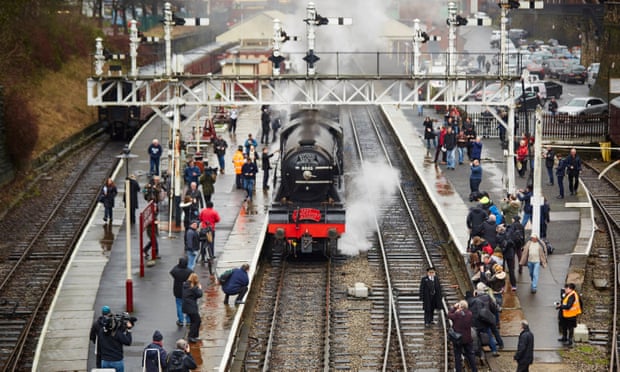by johnthefireman
Railroad Forums
Flying Scotsman
- Discussion about railroad topics everywhere outside of Canada and the United States.
Moderators: Komachi, David Benton
by philipmartin
"at one point it recorded what is thought to be the longest ever non-stop run by a steam locomotive, travelling 422 miles." I didn't think a steamer could go that far without being serviced along the way.
by george matthews
philipmartin wrote:"at one point it recorded what is thought to be the longest ever non-stop run by a steam locomotive, travelling 422 miles." I didn't think a steamer could go that far without being serviced along the way.There used to be troughs in the track where a non-stop steam locomotive could collect water at speed. The fireman lowered a scoop into the water and the speed forced the water into the tank in the tender.
by philipmartin
A BR film on a twelve to sixteen day servicing. https://www.youtube.com/watch?v=WcstP4bXtaE" onclick="window.open(this.href);return false;
Servicing an engine on the LMS, 1938. https://www.youtube.com/watch?v=Z0bToe9DKFo" onclick="window.open(this.href);return false;
Servicing an engine on the LMS, 1938. https://www.youtube.com/watch?v=Z0bToe9DKFo" onclick="window.open(this.href);return false;
by philipmartin
george matthews wrote: There used to be troughs in the track where a non-stop steam locomotive could collect water at speed. The fireman lowered a scoop into the water and the speed forced the water into the tank in the tender.Yes. We had them in North America too. But there's no way to add coal on the fly. I thought steamers needed servicing, not just coal and water, at perhaps half that 442 mile distance.
Here's a thread from Trainorders.com on the topic. http://www.trainorders.com/discussion/r ... 10,2631079" onclick="window.open(this.href);return false;
by johnthefireman
As well as the use of water troughs, which was fairly common in UK, some of the long-distance locomotives were fitted with a corridor tender so that crews could be changed en route without stopping. In preservation, Flying Scotsman would often run with a double tender to allow extra water to be carried, but as far as I know no British locos ever ran with a double tender in normal service. They didn't need to because in those days there were water towers on every platform and plenty of water troughs for the non-stop trains.
An extra water tank was common in South Africa, particularly for Garratts, where apart from the need for extra water, the draining of the water tanks above the driving wheels could affect traction, so water was normally drawn from the auxiliary water tank running behind the locomotive. South Africa also used condensing locomotives (Class 25) in the Karoo desert, where water was scarce, but they required a great deal of maintenance and most were eventually converted to normal non-condensing locos (Class 25NC).
An extra water tank was common in South Africa, particularly for Garratts, where apart from the need for extra water, the draining of the water tanks above the driving wheels could affect traction, so water was normally drawn from the auxiliary water tank running behind the locomotive. South Africa also used condensing locomotives (Class 25) in the Karoo desert, where water was scarce, but they required a great deal of maintenance and most were eventually converted to normal non-condensing locos (Class 25NC).
by johnthefireman
philipmartin wrote: I thought steamers needed servicing, not just coal and water, at perhaps half that 442 mile distance.I think broadly speaking you are correct. But non-stop runs of over 400 miles were not the norm by any means. Locos selected for these duties would be in good condition, well-serviced in advance, with good lubricators, etc. It would be a challenge for a fireman to keep a fire going for 400 miles without cleaning it, but then the loco would be working hard much of the time which would help to keep the fire clean, and drivers and firemen on such a duty would tend to be top notch blokes.
by philipmartin
johnthefireman wrote: drivers and firemen on such a duty would tend to be top notch blokes.Well, that lets me out. In 1977 I heard a supervisor talking about a man, (on the Lackawanna Railroad), who injured himself firing. He kept the engine going, but sacrificed himself.
by johnthefireman
philipmartin wrote:He kept the engine going, but sacrificed himself.Completely different context, but when I think of heroic railway crews I always think of Soham.
Soham rail disaster
by philipmartin
johnthefireman wrote: Completely different context, but when I think of heroic railway crews I always think of Soham.An inspiring story.
Soham rail disaster
by philipmartin
johnthefireman wrote: South Africa also used condensing locomotives, (Class 25) in the Karoo desert, where water was scarce, but they required a great deal of maintenance and most were eventually converted to normal non-condensing locos (Class 25NC).Here are photos from Wiki of condensing locos -a SAR class 25, number 3511, copyright Malcolm Best, and Metropolitan Railway (London Underground,) number 23.
by johnthefireman
Yes, condensing locomotives were also used on the London Underground, for different reasons.
I've fired the 25NC class, but the condensers were long gone before I started firing. I believe there might still be one example remaining in South Africa, but not operational.
I've fired the 25NC class, but the condensers were long gone before I started firing. I believe there might still be one example remaining in South Africa, but not operational.
by philipmartin
johnthefireman wrote:Here's 3511 in action. It was preserved. https://www.youtube.com/watch?v=SYEhFeFOeBs" onclick="window.open(this.href);return false;
I've fired the 25NC class, but the condensers were long gone before I started firing. I believe there might still be one example remaining in South Africa, but not operational.
From Trainorders.com about 3511: http://www.trainorders.com/discussion/r ... ?6,3335548" onclick="window.open(this.href);return false;
